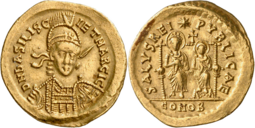| Basiliscus | |||||
|---|---|---|---|---|---|
| Emperor of the Romans | |||||
 | |||||
| Roman emperor of the East | |||||
| Reign | 9 January 475 – August 476 | ||||
| Coronation | 12 January 475[1] | ||||
| Predecessor | Zeno | ||||
| Successor | Zeno | ||||
| Co-emperors | Marcus Julius Nepos (West, 475) Romulus (West, 475–476) | ||||
| Died | Limnae (modern-day Cappadocia, Turkey) | ||||
| Spouse | Zenonis | ||||
| Issue | Marcus | ||||
| |||||
| Dynasty | Leonid | ||||
Basiliscus (‹See Tfd›Greek: Βασιλίσκος, translit. Basilískos; died 476/477) was Eastern Roman emperor from 9 January 475 to August 476. He became magister militum per Thracias in 464, under his brother-in-law, Emperor Leo I (r. 457–474). Basiliscus commanded the army for an invasion of the Vandal Kingdom in 468, which was defeated at the Battle of Cape Bon. There were accusations at the time that Basiliscus was bribed by Aspar, the magister militum; many historians dismiss this, instead concluding that Basiliscus was either incompetent or foolish for accepting Vandal King Gaiseric's offer of a truce, which the latter used to construct fireships. Basiliscus's defeat cost the Eastern Empire 130,000 pounds (59,000 kg) of gold, causing the empire to hover above bankruptcy for 30 years. When Basiliscus returned to Constantinople, he sought refuge in the Hagia Sophia. His sister, Empress Verina, secured him a pardon and he left the church to retire in Neapolis.
When Emperor Leo died in 474, his grandson Leo II (r. 474) took power, but soon died; his father, Zeno (r. 474–475, 476–491) ascended the throne in the same year, in a politically precarious position. Verina conspired to install the magister officiorum Patricius, her lover, as emperor. This plot was supported by Basiliscus, who succeeded in recruiting Isaurian brothers Illus and Trocundes, as well as Verina's nephew Armatus. Zeno fled on 9 January 475, either after learning of the plot or after Verina warned him that his life was in danger. Although Patricius was Verina's intended successor, Basiliscus convinced the Eastern Roman Senate to acclaim him instead.
Basiliscus quickly lost the support of his subjects and of his allies in court. Verina was alienated by the execution of Patricius, while the people objected to a combination of heavy taxes, heretical policies, and a natural disaster viewed as divine wrath for said heretical views. In an attempt to increase support, Basiliscus embraced the miaphysites, restoring Timothy Ailuros as the Patriarch of Alexandria and Peter the Fuller as Patriarch of Antioch. He heeded their advice and issued an encyclical on 9 April 475 which promoted the first three ecumenical councils of the church: Nicaea, Constantinople, and Ephesus, and condemned the Council of Chalcedon and the Tome of Leo. The Patriarch of Constantinople, Acacius, strongly opposed him, and together with Daniel the Stylite, turned the population of Constantinople against Basiliscus.
Zeno, besieged by Illus and Trocundes in his homeland of Isauria, convinced the two generals to defect, and soon the three of them marched their troops toward the capital. Basiliscus ordered Armatus to intercept them, but Armatus also switched sides after Zeno promised to give him the position of magister militum praesentalis for life, and make his son Basiliscus caesar. With Armatus' defense force deliberately kept out of his way, Zeno entered Constantinople unopposed in August 476. Basiliscus and his family hid in a church until Zeno promised not to execute them; exiled to Limnae in Cappadocia, they were either beheaded or imprisoned in a dried-up cistern and left to starve to death.
- ^ Pingree 1976.
- ^ Rösch 1978, pp. 166.